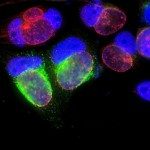Lien vers Pubmed [PMID] – 33712643
Lien DOI – 10.1038/s41598-021-85123-7
Sci Rep 2021 03; 11(1): 5848
The tumoral origin and extensive passaging of HeLa cells, a most commonly used cervical epithelial cell line, raise concerns on their suitability to study the cell responses to infection. The present study was designed to isolate primary epithelial cells from human ectocervix explants and characterize their susceptibility to C. trachomatis infection. We achieved a high purity of isolation, assessed by the expression of E-cadherin and cytokeratin 14. The infectious progeny in these primary epithelial cells was lower than in HeLa cells. We showed that the difference in culture medium, and the addition of serum in HeLa cultures, accounted for a large part of these differences. However, all things considered the primary ectocervical epithelial cells remained less permissive than HeLa cells to C. trachomatis serovar L2 or D development. Finally, the basal level of transcription of genes coding for pro-inflammatory cytokines was globally higher in primary epithelial cells than in HeLa cells. Transcription of several pro-inflammatory genes was further induced by infection with C. trachomatis serovar L2 or serovar D. In conclusion, primary epithelial cells have a strong capacity to mount an inflammatory response to Chlamydia infection. Our simplified purification protocol from human explants should facilitate future studies to understand the contribution of this response to limiting the spread of the pathogen to the upper female genital tract.

